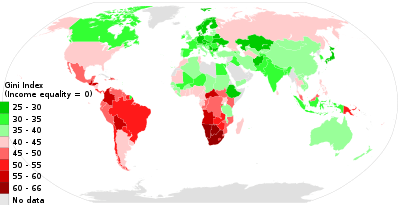ஜினி குறியீடு
ஜினி குணகம் (Gini coefficient) அல்லது ஜினி குறியீடு (Gini index) அல்லது ஜினி விகிதம் (Gini ratio) என்பது ஒருநாட்டு குடிமக்களின் வருவாய் சமனின்மை அளக்க உதவும் ஒரு குறியீடு.[1][2] மக்களுக்கிடையில் உள்ள பொருளாதார ஏற்றத்தாழ்வுகளை அளக்க இக்குறியீடே அதிகமாக பயன்படுத்தப்படுகிறது. இக்குறியீட்டின் மதிப்பு சுழிக்கும் (0)-வுக்கும் ஒன்றுக்கும் (1)-க்கும் இடைப்பட்டதாக இருக்கும். 0 என்பது முழு சமநிலையை குறிக்கும், அதாவது அந்நாட்டில் வாழ்பவர்கள் அனைவருடைய வருவாயும் சமம். 1 என்பது முழுக்க சமமின்மையை குறிக்கும். அதாவது அந்நாட்டின் மொத்த வருவாயும் ஒருவருடையதே. வேறு யாருக்கும் வருமானமே இல்லை என்று பொருள்.[3]

வருவாய் ஜினிக் குறியீடு வரைபடம் (உலக வங்கி தரவுகளின் படி)
குறிப்புகளும் மேற்கோள்களும்
- Gini, C. (1912). "இத்தாலியம்: Variabilità e mutabilità" 'Variability and Mutability', C. Cuppini, Bologna, 156 pages. Reprinted in Memorie di metodologica statistica (Ed. Pizetti E, Salvemini, T). Rome: Libreria Eredi Virgilio Veschi (1955).
- Gini, C. (1909). "Concentration and dependency ratios" (in Italian). English translation in Rivista di Politica Economica, 87 (1997), 769–789.
- Note: Gini coefficient becomes 1, only in a large population where one person has all the income. In the special case of just two people, where one has no income and the other has all the income, the Gini coefficient is 0.5. For 5 people set, where 4 have no income and the fifth has all the income, the Gini coefficient is 0.8. See: FAO, United Nations – Inequality Analysis, The Gini Index Module (PDF format), fao.org.
This article is issued from
Wikipedia.
The text is licensed under Creative
Commons - Attribution - Sharealike.
Additional terms may apply for the media files.